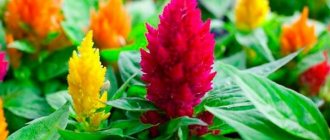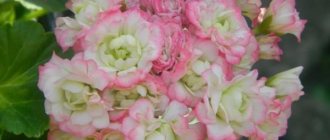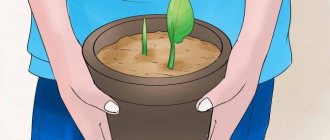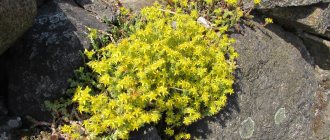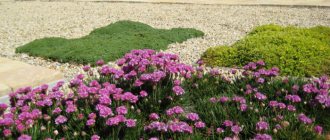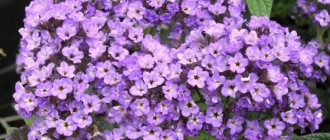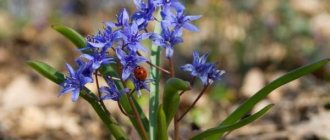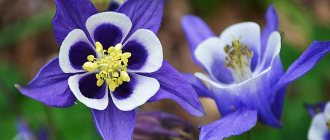Description of the Celosia flower
Celosia is an edible ornamental plant (less commonly a shrub), which in our latitudes is most often grown as an annual crop, since it cannot withstand sub-zero temperatures. The name "Celosia" means "burning" in Greek. The genus consists of about 45 species of herbaceous plants of the amaranth family (Amaranthaceae), native to tropical America and Africa.
Depending on the variety, plants grow to different sizes. Some reach a height of only 30 cm, while others can grow up to one meter or more. Scallops can have straight or branched shoots. The leaves have a lanceolate or ovate configuration.
Flowering of Celosia begins in the summer and often continues to bloom until the onset of autumn cold weather. The inflorescences are comb-shaped, paniculate or spike-shaped, formed from miniature flowers. It is difficult to find a flower with a more interesting shape and structure. The flowers of some varieties of Celosia look like flames, decorating your garden. The color of the inflorescences is quite varied - it can be pinkish, orange, golden, red, scarlet or yellow. The fruit is a multi-seeded capsule.
Description
Scallops (another popular name for a flower, received by the plant for the interesting curved shape of the inflorescences) belong to the Amaranthaceae family .
The genus has more than 60 species. In its natural environment, celosia can be found in tropical regions of Africa, South America and Asia. Celosia is presented in both herbaceous and shrub forms and belongs to dried flower plants. It has an erect branched stem, which is crowned with a spike-shaped, comb-like or paniculate inflorescence.
Celosia is distinguished by wide, elongated leaf blades of an elliptical or ovoid shape.
Interesting! In some varieties, the color of the leaves is not uniformly green, but spotted or with chaotic light stripes.
The height of the plant is determined by the species characteristics and ranges from 0.3 to 0.9 m. The flowering period of celosia is long: starting in June, it lasts until the end of September - beginning of October.
Flowers can be located in the axils of the leaves or on the stem itself, crowning it. After flowering, the inflorescences do not lose their decorative value and are used in dry compositions.
Where celosia occurs naturally, the plant has “edible” status. Young leaves and shoots are edible; The sprouts are also used for traditional medicine recipes.
How to grow Celosia in the garden
These flowers are fairly easy to care for, but the Scallop has a few special requirements. We recommend checking out our complete planting and care guide to help you grow your own Celosia plant.
You can buy seedlings of the flower at your local nursery or garden center, but it is also easy to grow from seeds.
Sowing Celosia seeds indoors for seedlings
The best method for growing Scallops from seed is to sow seedlings indoors about 6-8 weeks before the last average spring frost date.
Here's what you'll need:
- Celosia Seeds
- Container for seedlings or peat pots
- Good quality soil mixture for seedlings
- Artificial lighting or a well-lit window
- Warming mat (optional)
The process of planting Celosia seeds for seedlings is as follows:
- Moisten the soil, but do not oversaturate it with moisture. By squeezing a lump of soil with your hand, it should not fall apart, but water should not flow from it.
- The seeds can be pre-soaked for several hours.
- Fill trays or peat pots with moist soil mixture and sow seeds on top of the soil, one per cell or pot. Celosia seeds need light to germinate, so you should either just press them lightly into the soil or barely cover them with a small amount of soil.
- Place trays or pots in daylight. This could be a window that gets a lot of sunlight, or lighting for plants.
Seeds germinate best at a temperature of 20-26 °C. If your home tends to be cool in the winter, a heating mat can help to warm up the container from below. Keep the soil moist during the germination period. You can cover the trays with plastic lids or plastic wrap to retain moisture. Germination should occur in 1-2 weeks. Once you have seedlings, thin out the weakest ones, leaving only the strongest seedlings for planting outside.
Once your seeds have sprouted, remove the lid and it is advisable to increase the amount of light received. Water the seedlings and give them good ventilation while they sprout. Harden off the seedlings about 2 weeks before transplanting them into the garden.
Preparing and planting seeds
To grow celosia from seeds at home, you first need to choose a suitable place to place the crop. It is better to plant a flower bed in well-lit areas, but protected from the wind. You should also pay attention to the soil: it should be loose and low in acidity. Heavy soils are not suitable for celosia, since in such soil the crop will develop too slowly.
Note: Decorative crops respond well to organic fertilizers, so when preparing the bed, you can add compost or humus to the soil.
When the preparation of the area for the flower bed is completed, you can begin directly sowing the seeds:
- Celosia is considered a delicate crop, so it is recommended not to sow it directly into the ground, but to cultivate it using the seedling method. In a city apartment, seedlings can be grown in a pot, and in a private house - in a small greenhouse.
- Seeds must be properly prepared before sowing. To do this, take the preparations Zircon and Epin and add a drop of each of them for every 200 ml of liquid. You need to soak the seeds in the resulting solution for 3-4 hours to soften their dense shell.
- Sowing seeds for seedlings is usually carried out in March or April. Planting material can be laid out along previously prepared grooves or simply scattered over the surface of loose soil. In any case, there is no need to cover the seeds with soil. They just need to be lightly pressed into the soil and then moistened with a spray bottle.
- Next, the containers are covered with glass or film and placed on the windowsill. It is important that the plant is not exposed to direct sunlight, which can be detrimental to young shoots.
- The temperature in the room with seedlings should be +22+25 degrees. The room also needs to be regularly ventilated and accumulated condensation removed from the film or glass.
Figure 2. Stages of sowing seeds for seedlings.
With proper care, the first shoots will appear within a week and will have to be thinned out or pruned. But, if you don't want to do this, you can immediately sow the seeds in individual pots (Figure 2).
Planting Celosia seedlings or seedlings in the garden
What you need to know when planting Scallop in a flower garden.
When to plant
Celosia is sensitive to cold, so wait until all frosts have passed in the spring. This also applies to direct sowing of seeds. Be careful as this is a heat-loving plant. Wait until the soil has time to warm up. Typically, seedlings are planted in early to mid-May in colder climates and April in warmer regions.
Where to plant Celosia: choosing a place
You can grow the flower in open ground or in containers. Scallops are equally good in both cases, but if you plan to use containers, it is advisable to choose varieties with shorter stems.
Celosia loves sun and warmth, so find a place where the flower will receive enough sunlight. These plants need at least eight hours of sunlight every day.
What soil is suitable for growing scallops?
The flower is drought tolerant, but does not like stagnant water, so make sure your planting site has good drainage. It's the same with pots. Use a good quality potting mix that drains well, and make sure your pots have drainage holes in the bottom.
If you have clay soil on your site, it is best to mix it with perlite or coarse sand before planting the seedlings. It will be better if you add some nutrients to the soil. Add compost before planting to add organic matter to the soil.
Planting Scallop seedlings
Celosia can be planted just like any other seedling. Once you've prepared your flower bed or container, simply dig holes that are roughly the same size at the root balls of your plants. Make sure the soil is well warmed up before planting Celosia.
If you grew your seedlings in peat pots, you can plant the seedlings in them, but tear off the bottom of the container so the roots have somewhere to grow. Otherwise, carefully remove each seedling from the pot and insert it into one of the holes. Cover each seedling with soil so that the top of the root ball is covered with soil. Lightly tamp them down with your hands to prevent them from falling.
The last step is to water the planting area well. To prevent weed roots from killing your seedlings, when planting your seedlings, apply a few inches of organic mulch around the seedling to prevent weeds from germinating.
Growing seedlings
To ensure that cockscombs begin to bloom earlier, it is better to grow them as seedlings. Propagation by cuttings is possible, but in this case the flower loses its decorative appearance.
When using method 1, you must adhere to the following rules:
- Seeds should be sown in March - April. You can buy them or assemble them yourself.
- Before this event, the seed material must be kept in a warm solution of potassium permanganate for 2-3 hours.
Celosia comb or cockscomb - photo - The soil used for planting must be well moistened. It is better to use a mixture purchased in a special store.
- When planting, the seeds should be placed at a distance of 2 cm from each other.
- They need to be lightly pressed into the planting soil.
- Containers with seedlings should be covered with transparent film and placed in a warm room.
- When seedlings appear (5-7 days after planting), the film must be removed and the seedlings placed in the sun.
- Plants require moderate but regular watering.
If there is little light in the room, it is better to install lighting.
After 2 true leaves appear, you can start picking into peat or plastic glasses. If the plants are very elongated, then when performing this procedure the stem should be immersed in the ground up to the leaves. It will become shorter, but stronger. The root system will be more powerful.
Advice! You can plant the seeds directly in cups to avoid diving.
Thus, growing seedlings is not difficult. You just need to follow the experience accumulated by gardeners.
Expert opinion
Yulia Yurievna
I have a large garden and vegetable garden, several greenhouses. I love modern methods of cultivating plants and mulching the soil, and I share my experience.
Ask a Question
Regardless of whether the soil is prepared yourself or purchased, it is better to disinfect it. This can be done by calcining the substrate in the oven or by pouring boiling water over the soil. During germination under film, we recommend ventilating the seedlings daily. After sowing and picking the plants, it is better to water them with a weak solution of manganese. This will protect the flowers from fungal infection. Before transplanting flowers into open ground, cockscomb flowers must be hardened off. To do this, containers with seedlings need to be taken out into the garden, having first chosen a place protected from the wind with diffused light. At first, the plants are left outside for no more than 2 hours, increasing the duration of walks over time.
Sowing Celosia seeds in open ground
You can grow Scallop by sowing the seeds directly in the flower bed. This method has its pros and cons.
Celosia seedlings do not always tolerate transplantation, so sowing seeds directly into the ground avoids this problem. However, if you live in more northern regions and don't have a long growing season and your plants will take a while to flower - you may miss out on most of their flowering time.
If you live in a milder climate with a long season, starting your seeds outdoors is your best option. Celosia usually begins to bloom in mid to late summer. The flowering period will take longer if you decide to plant the plants from seeds outdoors in the spring.
The process of sowing in open ground is as follows:
- Preparing the site. Get rid of rocks, weeds and debris. Mix compost or manure into the soil to increase nutrient levels at the planting site.
- Level the surface of the soil until it is relatively smooth.
- Plant Celosia seeds up to 3cm deep and barely cover them with soil. Remember that they will need light to germinate.
- Water the newly seeded area well and keep it moist while the seeds germinate. Once the seedlings appear, allow them to grow for a week or two. Then, if necessary, you can plant them in the right places.
Care after flowering
After flowering has finished, celosia will need a little more attention.
How and when to collect seeds
In the fall, after flowering has ended, you can collect the seeds . To do this, cut off several inflorescences and place them in a vessel with water.
After a few days, the seeds ripen and can be shaken out onto a light cloth or paper. Then the collected planting material is removed for storage.
Celosia in winter
The flower cannot overwinter in open ground, so after collecting the seeds it is dug up and burned.
Further care for the Celosia flower
The scallop is not a capricious plant and requires a lot of attention. You just need to follow some procedures described below.
Watering
Established plants are drought tolerant, but you will need to water the seedlings regularly until they are established. Water mature Celosia when the top layer of soil dries out. Always check the soil first to see if the flower needs watering. Never allow moisture to stagnate, as Scallop is prone to root rot, which will quickly kill the plant. Water once or twice a week in summer. Seedlings need more water than mature plants.
You might be interested
List of the best applications for identifying plants from photos
List of the best blue flowers and plants with blue foliage
Anafalis - an original garden decoration
Fertilizer
In most cases, Celosia does not need to be fertilized, but you can apply a balanced fertilizer about once a month if you want the plants to look fuller.
You can add a layer of mulch around your flowers to keep them looking nice and to suppress weeds, but don't overdo it. Soil that is too wet will cause rot.
Celosia pruning
To give the plant shape, pinch off its longer stems. Remove leaves that look unhealthy or have dried out. Do not pick the leaves; cut them off with sharp garden shears. Also be sure to remove dead flowers as this will encourage new buds to grow. Broken stems should be cut below the break point. Never leave damaged stems on Celosia, as this can lead to disease. Taller varieties of Celosia may need staking, especially if you often experience strong winds.
When to plant celosia for seedlings: optimal timing
If you love bright and unusual flower crops, then you should definitely plant celosia seedlings so that at the end of spring you can plant them in a permanent place in the garden. But when is it better to plant celosia seedlings, in what month? It is better to carry out the procedure at the end of March or at the beginning of April . However, when choosing the time for the procedure, do not forget that in different regions due to different climatic conditions, the timing may differ:
- In the central zone (including the Moscow region) you can plant seeds at the end of March.
- In Siberia, the Urals, and the Leningrad region, it is better to sow in early April.
- In the south, you can sow without problems in mid-March.
By the way, when choosing the timing for sowing celosia seedlings, you can focus on the Lunar calendar of 2022:
- Favorable days for the procedure: in January: 1, 10, 11, 15, 16, 19, 20;
- in February: 7, 8, 12, 13, 14, 15;
- in March: 10, 11, 15, 20, 21, 24, 25.
- in January: 2, 18th;
Pests and diseases
Celosias are generally hardy but susceptible to fungal diseases. Check regularly for damaged areas on the leaves that appear as brown spots. Trim off affected leaves to prevent the fungus from spreading to the rest of the plant. Grayish-black spots on the stems may indicate root rot. Ventilate Celosia plants generously and make sure they are in an area that receives plenty of sunlight. If you keep the flower indoors, it may attract mites that feed on the sap of the leaves. To control mites, lightly spray the leaves with a mixture of one teaspoon of mild dishwashing liquid in one liter of water.
Plants that do not have time to grow stronger may become infected with blackleg.
Photo of seedling damage by “black leg”
This disease can be prevented by watering only in the morning (before 9:00 am). In cloudy times, it is not recommended to moisturize. If disease damage is detected, the soil should be thoroughly loosened and then sprinkled with wood ash, watering should be significantly reduced.
Features of caring for indoor celosia at home
Indoor celosia is not a very capricious indoor flower. The main thing is to provide her with sufficient lighting, which should not be bright, and direct sunlight should be diffused using tulle or other material. In the room where the flower stands, it is better to maintain the temperature within 15-16 degrees, and if it rises to 20 degrees, the room should be ventilated more often.
Water for irrigation should be filtered and at room temperature. When watering, you need to make sure that drops of water do not fall on the buds. The soil in the pots should be moist, but not waterlogged. Periodically, celosia foliage is sprayed with a spray bottle.
Celosia flower in garden landscape design
The comb looks great in combination with decorative stones or small shrubs. Often the flower becomes an addition to voluminous flower beds and ridges.
Low-growing varieties are used in the formation of flower beds, carpets, for growing in hanging flower pots and balcony containers. Scallops can be planted either individually or in group compositions. Their celosias form beautiful bouquets; they are able to delight for a long time with their beautiful appearance.
In some countries, the plant is used for medicinal purposes - to combat vision problems and oral pathologies. In China, it is grown to make healing tea.
Planting celosia
The photo shows celosia with unusual variegated leaves.
When to plant celosia seedlings in a flower bed
Like other heat-loving plants, celosia seedlings are planted in the garden at established above-zero temperatures.
You will be interested to know: Eustoma: secrets of growing from seeds, planting and care in open ground
Choose a sunny area for flowers, protected from drafts. However, here you need to pay attention to important points:
- In summer, the bright inflorescences will fade from the midday sun. Therefore, try to select an area for the celosia that will be in the shade at noon and lit the rest of the time.
- In the shade, you won’t see brightly colored flowers, and the blooms will be sparse. Therefore, planting celosia under trees and canopy is a bad decision.
You also need to pay attention to the acidity of the soil. If it is acidic, add lime or dolomite flour.
How to plant celosia
Dig up the flowerbed, level the ground and make holes for planting celosia according to a pattern of 25-30 cm for tall plants and 15-20 cm apart from each other for low-growing varieties.
Pour water into each hole and place the plants in them along with a lump of earth. Cover the roots with soil and press down gently to avoid breaking the fragile roots and stems. Water the plantings with settled water from a barrel.
If the seedlings are planted in a sunny place, cover them with lutrasil or other non-woven material for several days.
Varieties of Celosia
In nature, there are up to 45 species of Scallop, and the varietal diversity is even greater. The most popular types:
Silver Celosia (Celosia argentea)
There are also other names for this species - Celosia comb or pinnate. The height of the stem is up to 65 cm, miniature flowers create voluminous fluffy inflorescences.
The color is different - yellow, scarlet, red with purple hues. It is distinguished by a long riot of buds - from the first half of July to October. The most famous variety is “Impress”. The characteristic difference is a rich burgundy hue, dark purple leaves.
Varieties of celosia comb
Photos of comb celosia in a flowerbed demonstrate the diversity of annual varieties. You can name several of the most popular types.
Impress
The dwarf variety grows to only 25 cm above the ground. The leaves of the plant are dark, with red veins, and the inflorescences are wine-red or deep burgundy.
Celosia Impress blooms in mid-June
Empress
The popular variety produces deep purple inflorescences with a crimson tint. The decorative effect is enhanced by beautiful purple-green leaves. The variety is unpretentious and tolerates mild drought and lack of sun.
Celosia Empress grows to an average of 30 cm
Atropurpurea
A miniature variety with light green leaves and a dark stem blooms with burgundy-crimson inflorescences. The panicles are quite large and look bright in the garden, despite the compact size of the annual.
Attention! Celosia Atropurpurea can be grown not only in open soil, but also in pots. The height of celosia Atropurpurea does not exceed 20 cm
Coral Garden
The medium-sized variety reaches about 50 cm above the ground. Bears relatively small but spectacular panicles of pink-crimson or red-orange hue.
The Coral Garden variety develops well on light soils and is suitable for alpine hills
Types of celosia flowers (with photo)
Of the many types of celosia, Hutton's celosia (spike-shaped) and silver celosia are used for cultural cultivation. Celosia varieties are divided into low-growing and tall-growing.
Celosia Hutton is a highly branching plant. It reaches a height of 60–100 cm. It blooms with spike-shaped inflorescences-panicles of different colors.
Hutton's celosia cultivar Pink Flamingo has bushes 60 cm tall and flowers from bright to pale pink.
The varieties Flamingo Feather and Flamingo Purple have inflorescences that differ in color saturation, as well as different periods from planting to the flowering period.
Celosia silvery pinnate is distinguished by lush panicle inflorescences, which can reach the length of the stem. The leaves, stems and flowers of this plant have different colors.
Celosia variety Goldfeder, which belongs to the silver species, reaches a height of no more than 25 cm and has golden-yellow inflorescences.
Celosia variety New Look has a height of 40 cm, the inflorescences are red and large.
The Fresh Look variety reaches only 35 cm in height, and its inflorescences are bright red and golden yellow.
Celosia variety Feuerfeder is low (25 cm) and is distinguished by fiery red inflorescences.
Celosia variety Pampas has a height of 60–80 cm, and the inflorescences can be of different colors.
Look at the photo of celosia flowers, where the brightest varieties and varieties are presented:
Celosia is widely used for making dry flower arrangements. After hanging dry in a dark, ventilated room, its yellow and red inflorescences retain their shape and color well.
Silver celosia is an annual upright growing plant with a strong thick stem, 20–100 cm high; blooms from July until the first frost. It got its name from the Greek word “kelos” - burning, blazing. The inflorescences actually seem to be on fire - they are so bright. According to the shape of the inflorescence, consisting of small flowers, celosia is divided into two garden forms: pinnate, which has paniculate inflorescences of yellow, orange, salmon, bright red, purple, less often cream color, and comb, which received its name for the original thick inflorescence in the form of a comb . Celosia looks great both in flower beds and in bouquets. It is planted on balconies, ridges, and in containers.
Silver comb celosia, or Cockscomb (Celosia Argenteal. F. Cristata (L.) Kuntze).
An annual herbaceous plant up to 70 cm high. Stems are erect, often fused (fasciated), succulent. The leaves are oval, pointed, green, variegated or dark purple. The flowers are small with yellow, orange, pink and mostly purple-red perianth, collected in a massive inflorescence with more or less large, deep convolutions along the upper edge, reminiscent of a cockscomb. Blooms from early July until the first frost. It sets seeds abundantly, but they do not ripen completely.
Celosia silvercrest is usually grown as an annual plant. Its inflorescences look like a cockscomb. They are purple, pink, and yellow in color. Celosia of this type of Coral Garden variety reaches only 30–40 cm in height, and its inflorescences are varied in color. Celosia variety Chief Series is taller - 80–100 cm, with large inflorescences of red, pink, yellow. Celosia varieties Jewel Box Series are characterized by a small height (up to 15 cm) and inflorescences of red, carmine and yellow colors.
Celosia Argentea LF Plumosa Voss.
An annual herbaceous pyramidal plant up to 100 cm high. The stems are straight, fleshy, ending in large, paniculate inflorescences. The flowers are small, silvery, shiny, dry, collected in spike-shaped cylindrical inflorescences, located both at the top of the stem and in the axils of the leaves. The leaves are linear-lanceolate or almost linear on short petioles.
The varieties differ in the color of the inflorescence (golden-yellow, silver-yellow, fiery red and others) and the height of the plant.
Common varieties
Breeders are engaged not only in improving the aesthetic properties of flowers, but also in adapting them to our climate. Low temperatures remain detrimental to flowers, but their resistance to midland weather has noticeably increased. Therefore, most gardeners successfully work with numerous varieties of feathery celosia.
Among the varieties of low-growing paniculate celosias and dwarfs, the following are in demand.
- "Kimono" is a compact and low plant with a large spherical inflorescence. Color - from white to cherry red, cream, yellow, orange.
- "Glorias Mix" is a variety with a wide range of bright colors with excellent density and uniformity. Ideal for use in the decoration of both streets and apartments.
Among the medium-growing varieties, the following varieties stand out in popularity.
- "Fresh Onions" with golden yellow and flaming red inflorescences.
- "New Onion" with large wide inflorescences of fiery red color.
- "Peacock" is an annual with ribbed emerald leaves. The paniculate inflorescences of its flowers range from orange and yellow to red hues.
Among the tall species and giant varieties, the “Pampas Plume” and the “Summer Bonfires” variety, a regular pyramidal bush with large paniculate inflorescences of yellow, pink and red, amaze with their mixture of bright colors.
Cockscomb flowers - description
Celosia comb is the correct name for cockscombs. They belong to the amaranth family. They can be either annual or perennial.
Blooming cockscomb (photo)
The stem of the plant is green or reddish in color. It's juicy. The color of the leaves has a rich color palette - from green to dark purple.
The height of these plants is up to 35 cm. The flowers are small, colored in yellow, orange, red, purple and pink.
Flowering begins in July and lasts until the first half of October. So, such plants can add a touch of originality to even the most sophisticated garden composition.
Planting and propagation
Garden celosia can be propagated simply by seeds. They are planted in March in loose soil, carefully scattered over the surface. After this, sprinkle them with warm water and leave them under the film until shoots emerge, spraying them periodically. The greenhouse can be removed when the seedlings get a little stronger.
As necessary, seedlings can be planted and even fed a little with liquid fertilizers. Make sure they have at least 5 hours of bright light and always be warm. Celosia is transplanted into the garden only when the threat of frost has completely passed.
But propagation by cuttings, which is usually better suited for garden plants, is not very suitable for celosia. The problem is that this way the variety loses its decorative properties. But in general, if desired, the cuttings can be easily rooted in damp sand in about 2 weeks.
Photo: sakataornamentals.com
Celosia – photo
Celosia varieties seem to include every shade of yellow, red, orange, pink and crimson. But even this is far from the limit!
Photo: pixabay.com
Photo: pallensmith.com
Photo: pinterest.co.uk
Photo: fruit-grower.info
Photo: liveinternet.ru
Photo: 7dach.ru
Photo: fedsp.com
Photo: photocentra.ru Photo: fotokto.ru
Photo: fotokto.ru
Photo: diz-cafe.com
Photo: jardineriaon.com
Photo: purebeautyfarms.com Photo: happymodern.ru
Photo: grow-me.ru
Photo: styldoma.ru Photo: rastenievod.com
Photo: flo.discus-club.ru
Photo: decorumplantsflowers.com
Photo: tripchik.ru
Photo: etsy.com Photo: catalog.gardencenterohio.com
Photo: pixabay.com
Photo: baremtnfarm.com
Photo: garden.org
Did you like the post? Subscribe to our channel in Yandex.Zen, it really helps us in our development!
Facts about celosium
- Since ancient times, silver celosia has been used as a food plant in Indonesia, India, Nigeria, and Central America. Celosia's young leaves and shoots are edible.
- Celosium oil is extracted from scallop seeds.
- In folk medicine, celosia is used to expel worms, to treat blood diseases, mouth ulcers, and vision problems.
- Silver celosia (lat. Celosia argentea) is actively grown as a garden ornamental plant (usually as an annual used for organizing borders), as a cutting plant, and also as a potted plant.
- Silver celosia was introduced into cultivation during the Renaissance, so it has long become a common plant for European gardens.
- Varieties of silver celosia are divided into two groups: the Plumosa group includes varieties with inflorescences in the form of a plume of small deformed flowers of various colors (plants of this group are grown for cutting); to the Cristata group - varieties with inflorescences in the form of wavy ridges of fused shoots.
Cockscomb flowers - types and varieties
The silvery variety of comb celosia is often cultivated as an annual. Although by nature it is a perennial plant. The height of the bush reaches 50-100 cm. There are oval or elongated leaves along the entire length of the stem. Flowering begins in mid-summer.
The comb variety of this plant has straight, powerful, succulent stems that rarely reach a height of more than half a meter. The leaves are light, the inflorescences are round or umbrella-shaped. They are made up of small fluffy buds. Arranged in sinuous lines with fringe at the ends.
Paniculate species come in different heights: from 25 cm to 1 m. The shoots are straight and have gray-green leaves. Towards mid-summer, tall panicle-like buds appear. They come in pink, red, yellow or fiery.
Spikelet types of cockscombs grow a little more than a meter and look more delicate. Their buds look like spikelets. The most common shades are yellow and orange. Flowering begins from the lower part of the inflorescence, which becomes lighter.
